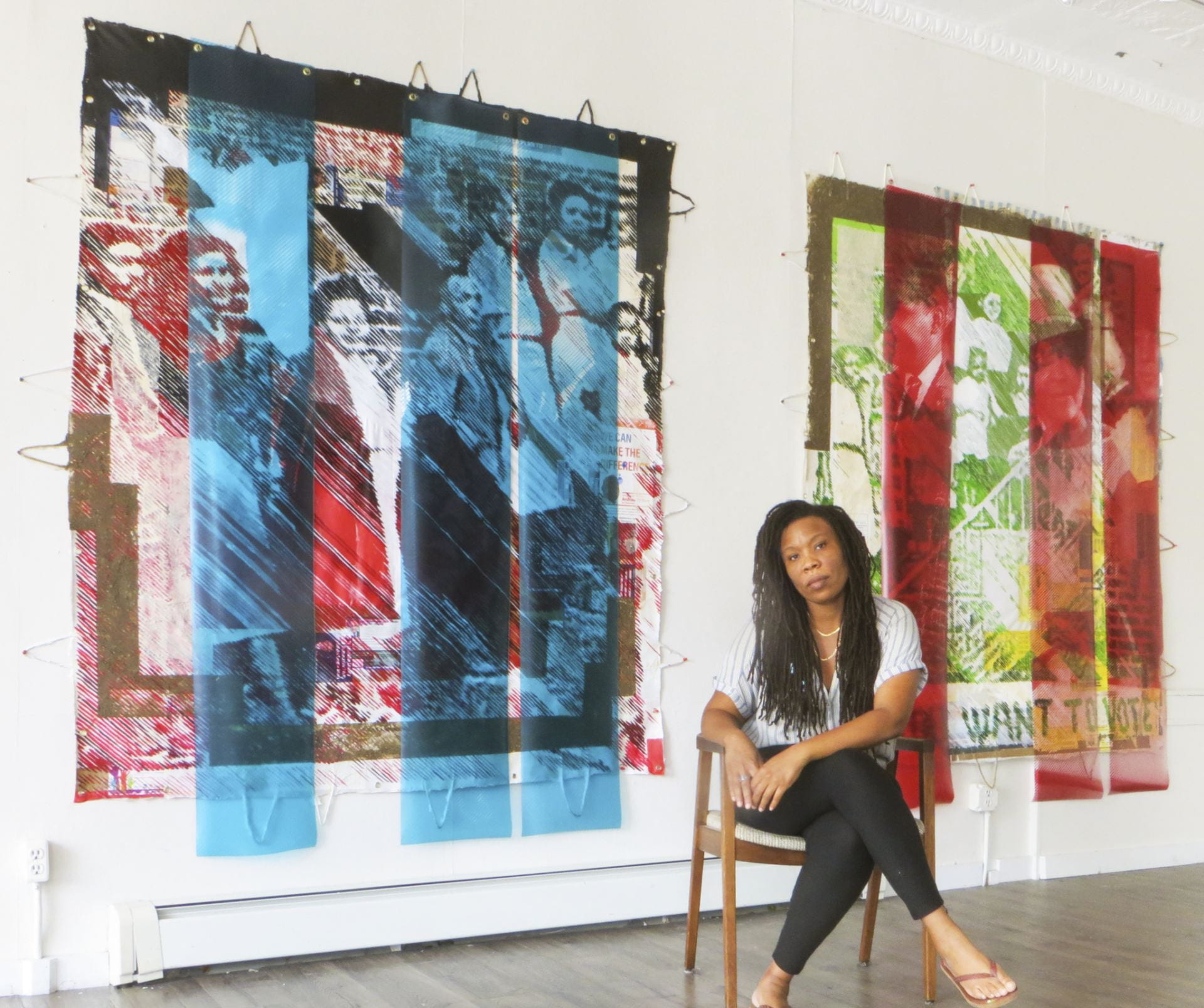
Artist Tomashi Jackson sits in front of installation “Love Rollercoaster” at the Wexner Center for the Arts. Credit: Courtesy of the Wexner Center for the Arts
Amid an incredibly contentious election season, the Wexner Center for the Arts has launched four new exhibitions that invite its viewers to think about voting and democracy.
The exhibitions — “Aggressive Witness—Active Participant,” “Remember Me,” “Assembled Audience” and “Love Rollercoaster” — opened Saturday and will be on display through Dec. 27. Although the exhibitions are not linked together in any way, Kristin Helmick-Brunet, curatorial associate at the Wexner Center, said each one invites visitors to think deeply about their role in American democracy.
“I’m hoping that people will connect back to the fundamentals of our democracy and what makes America so important,” Helmick-Brunet said.
“Aggressive Witness—Active Participant,” created by artist Gretchen Bender, is one of the more explicitly political pieces being shown, Bill Horrigan, curator-at-large at the Wexner Center, said. It consists of eight box-screen televisions playing live cable TV with graphics naming contentious topics — such as “Lesbian & Gay Rights,” “No Criticism” and “Class, Race and Gender” — overlaying them with four computer monitors displaying other graphics interspersed between them, Horrigan said.
Horrigan said the exhibition isn’t exactly a pleasant piece of art.
“It’s very kind of cacophonous and kind of willfully an assault of peace,” Horrigan said.
He said it asks the viewer to think about what the news does — and doesn’t — discuss.
“In some ways, it’s about how mass media, television in particular, constructs a certain kind of reality to the expense of others,” Horrigan said.
Moreover, Horrigan said the piece is an example of how its message — that television constructs a certain kind of reality at the expense of others — transcends time, as it was originally created in 1990 and is being displayed again for the Wexner Center’s 30th anniversary.
The exhibition “Remember Me,” made by filmmaker and visual artist Steve McQueen, is a much gentler, more intimate piece, Horrigan said. It consists of numerous neon signs with the phrase “Remember Me” in different scripts and handwriting. The exact meaning, however, is left up to the viewer, Horrigan said.
“You don’t know whether ‘Remember Me’ is a plea, an order, a request. It’s kind of ambiguous,” Horrigan said. “It’s very primal and quite meditative.”
The exhibition “Assembled Audience,” made by Taryn Simon, is different from the other exhibitions, as it is almost entirely an auditory experience, Helmick-Brunet said. Over the course of an entire year, she said Simon recorded applause from audience members at events in Columbus’ three largest venues: the Nationwide Arena, the Schottenstein Center and the Greater Columbus Convention Center. The events ranged from a Justin Timberlake concert to a political rally, and the exhibition includes a list detailing the date, event and name of every single person recorded.
Helmick-Brunet said the purpose of the exhibition is for us to question the nature of our applause.
“Who are we giving our applause to? Are we doing it as a crowd or are we doing it as individuals? Is there any individual ownership in our applause? Are we influenced by others?” Helmick-Brunet said.
“Love Rollercoaster,” made by Tomashi Jackson, is a series of paintings exploring the history of voter disenfranchisement and suppression of African American communities, specifically in Ohio, Helmick-Brunet said. Along with bright colors, Jackson used local and national political paraphernalia, contemporary and archival photographs, and clay dust from both a local park and Athens, Greece, in her paintings.
The exhibition will also feature a playlist of background music from the Dayton, Ohio, band Ohio Players, which Jackson said she listened to while working on the paintings and from which she drew the exhibition’s title. Interspersed with those songs will be excerpts from interviews Jackson had with Ohio residents on the topic of voter suppression, Helmick-Brunet said.
Helmick-Brunet said the original plan for the exhibition was to include voter registration and absentee ballot request forms for visitors to fill out. Due to not wanting ink pens so close to the paintings, Helmick-Brunet said the voter registration forms have been moved to the nearby “Free Space” exhibition, and absentee ballot requests can be found at the front desk of the Wexner Center.
Although “Love Rollercoaster” is definitely the most political of the new exhibitions, Helmick-Brunet said she hopes all of them remind people of the tenets of American democracy and how important it is to be a part of it.
“They have such a fundamental, important message, just for the basis of what American democracy is,” Helmick-Brunet said. “I think it’s very important to put that message back out there because it can get lost in a lot of the noise and the static.”
Beyond the political ideas is the broader hope that visitors will enjoy themselves and find meaning in the artwork, Horrigan said.
“We want people, mainly, to enjoy themselves, be entertained, have their minds provoked, opened a bit. We want the works to be provocative, helpful and memorable,” Horrigan said.
“Aggressive Witness—Active Participant,” “Remember Me,” “Assembled Audience” and “Love Rollercoaster,” will be on display through Dec. 27 at the Wexner Center for the Arts. The Wexner Center is open Tuesday, Wednesday and Friday through Sunday from 11 a.m. to 5 p.m. and Thursday from 11 a.m. to 7 p.m. Admission is free for college students on all days with a valid ID, and for general members on Thursdays after 4 p.m. and on the first Sunday of every month. For all other times, tickets cost $9 for the general public and $7 for senior citizens, Ohio State faculty and staff with a BuckID.


